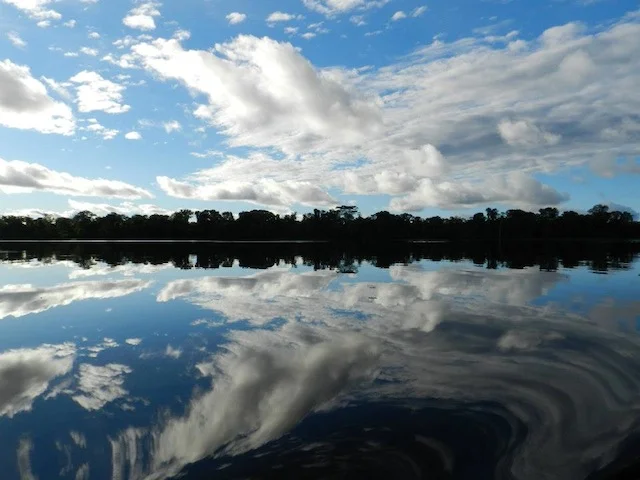A Guide To Pacaya Samiria
Pacaya Samiria National Reserve covers an area larger than 20,000 square km (5 million acres) and is located in Peru's Loreto Department. The park currently protects around 1.5% of the total surface area of the country, making it the largest national park in Peru, and the second largest ecological reserve in the entire Amazon, behind Grao-Para Ecological Station of Brazil.
‘Jungle of Mirrors’ effect in Pacaya-Samiria Reserve.
Established in 1982, the Reserve lies in the wedge of rainforest bounded by the confluence of the Marañon and Ucayali rivers, both major tributaries of the Amazon, and ends at their confluence near the town of Nauta, located 183 km (114 miles) southwest of Iquitos.
The Pacaya-Samiria Reserve is part of the National System of Natural Areas and is protected by the Peruvian Government. Its administration is in the hands of INRENA (The National Institute of Natural Resources), which has offices in Lima and Iquitos.
The principal objective of the Reserve is to protect the incredible biodiversity of the flooded whitewater forest (varzea) of the Omagua region, as well as to promote the sustainable development of local towns and villages.
Red & Blue Macaw in Pacaya-Samiria.
Wildlife of Pacaya-Samiria:
The Reserve boasts some of the Amazon's most abundant biodiversity.
Scientists have registered the presence of 527 species of birds, 102 mammal species, 69 species of reptiles, 58 amphibian species, 269 different kinds of fish, and 1,024 species of wild or domesticated plants.
This incredible concentration of life is made possible by the abundant rainfall and stable temperatures typical of the region. Annual rainfall ranges from 2,000 - 3,000 mm and temperatures range from 20ºC to 33ºC (68ºF - 91ºF).
Just a few of the endangered, charismatic megafauna one has the possibility of viewing while touring the wild Amazon jungles of Pacaya-Samiria are:
Giant River Otter
Red Macaw
Jaguar
Black Caiman
Amazonian Manatee
Natural Cycles of Pacaya-Samiria:
You have two choices in deciding when to visit Reserve: high or low water season. The cycle of crescent and reflux of the rivers is a fundamental characteristic of this protected area.
Flooded forest during Pacaya-Samiria’s high water season.
Each year, between the months of October and April, heavy rains fall and the water levels in creeks and rivers rises.
This makes for easy accessibility by motorboat, and is the period which gives Pacaya-Samiria the name 'Jungle of Mirrors', owing to the impressive reflections off the abundant black water.
Conversely, from May to September, when rainfall decreases, the water levels gently retreat, reaching their lowest levels in August of each year.
This time of year allows for some trekking within the park (owing to dry patches), and much better fishing, as the wildlife is concentrated in the streams and lakes.
The seasonal pattern of crescent and reflux are as vital to the Amazon as the tides are to the oceans, and provide two very different experiences when visiting the Pacaya-Samiria.
Over the course of thousands of years, wildlife has adapted perfectly to the cycle of crescent and reflux. When the forests are flooded, animals seek shelter in the highest areas which remain dry throughout the year.
During reflux, water that remains in small creeks and lakes provides refuge to immense concentrations of wildlife.
Large beaches also form which are used as nesting sites for animals such as the charapa and taricaya turtles, as well as humans who use the flat, fertile soil to plant crops such as rice, beans, and peanuts.
A small settlement in Pacaya-Samiria.
Human Settlement in Pacaya-Samiria:
It is important to remember that, although Pacaya-Samiria is considered a reserve and receives some protection from the Peruvian Government, it is still home to a number of native communities.
There is a population of approximately 42,000 people, who earn a living through subsistence farming, hunting, fishing, and gathering of forest products.
Tourism will undoubtedly remain an important income stream for native communities.
Amazon handicrafts for sale during Delfin III cruise itinerary.
Therefore, visitors to the park are encouraged to buy handicrafts at fair value from local artisans. The tourism industry helps to preserve the national park, by providing jobs which reduce the pressure to hunt and harvest wood illegally.
So, participation in a tour of the Amazon jungle helps to preserve the rainforest by providing economic alternatives to local populations.
How to visit Pacaya-Samiria:
Nearly all Amazon riverboat cruises offered by PeruNorth visit this important reserve, as it is relatively easy to reach from Iquitos, or the Amazon port town of Nauta, which is a 90-minute drive from the airport.
Alternately, there are a number of Amazon lodges located on the outskirts of the Reserve and which offer day trips by small boat into it. One of these is the appropriately-named Pacaya Samiria Lodge, which is on the banks of the Marañon River, directly opposite the Reserve.

